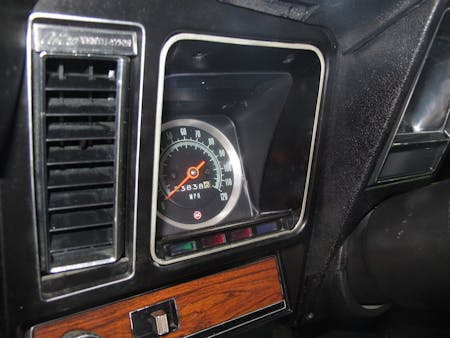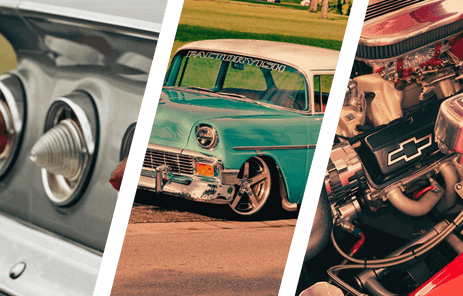 In 1969, before anyone slapped a Nickey, Baldwin, or Yenko moniker on the slightly-updated but still first-gen Camaro, Chevrolet was already offering several high-performance variants. But, Chevy needed to toe the line on GM’s edict that forbade engines larger than 400 cubic-inches in their F-body offerings. An edict that was eventually nullified by crafty dealers such as Don Yenko and Dick Harrell.
In 1969, before anyone slapped a Nickey, Baldwin, or Yenko moniker on the slightly-updated but still first-gen Camaro, Chevrolet was already offering several high-performance variants. But, Chevy needed to toe the line on GM’s edict that forbade engines larger than 400 cubic-inches in their F-body offerings. An edict that was eventually nullified by crafty dealers such as Don Yenko and Dick Harrell.
In 1969, scheduling hand-picked Camaros using the Central Office Production Order (COPO) system, these men were able to drop two variants of GM’s powerful 427ci engine between the wheelhouses of Camaros, albeit against the wishes of top brass at GM. COPO Camaros built through this program are of course, desirable, but in actuality, they don’t overshadow the L89 Camaros that were offered through Chevrolet dealer showrooms.
Playing within the rules and keeping the cubes at 396, it isn’t the horsepower numbers that constitute their collectability. There were only 311 L89-equipped Camaros produced in 1969, and even fewer (272) the year before. With such low production, these Camaros still enjoy a highly-collectible status. There were also an interesting amount of corporate card-games going on within the marketing department at Chevrolet, that adds to the legacy of these high-powered pony cars.
The Solid Foundation
Starting in 1965, the L89’s foundational engine, RPO L78, was originally rated at 425 horsepower. For some reason, it was then down-graded to 375 ponies. Whether done to give credence to the 427ci engine on the horizon, or to simply make it more palatable to insurance companies is up for discussion. Regardless, it has been proven the only thing that changed throughout the engine’s production life-cycle was the horsepower rating. Assembly of the L78 engine used the same components for both horsepower ratings, so any change was merely on paper.

The L78 utilized a solid-lifter camshaft, forged-steel crankshaft, and forged, domed pistons building a compression ratio of 11.0:1. Many feel that the actual numbers remained at least, or above, the originally-listed 425 horsepower. Reportedly, that number was registered at 6,400 rpm, while the lower 375 horses were actually realized at 5,600 rpm.
It seems almost laughable that to “tame down” this highly-fortified, solid-lifter engine, the listed horsepower rating was made simply by utilizing only a partial sweep of the tachometer. The reality of the sleight of hand comes into play as GM historian Doug Marion describes the L78 engine, “The L78, 375 horsepower 396 was very powerful, and it revved higher and better than any other RPO big-block.” It was the darling of racers a couple of years earlier in Corvettes and Chevelles, but finally found its way into the Camaro mid-way through 1967 production.
The Lightweight Option
By 1969, performance enthusiasts had become accustomed to clicking the L78 option box when ordering a new Camaro. In 1969 alone, 4,889 power-hungry customers paid the extra $316 to get an L78 Camaro. To get the lighter, aluminum-headed L89 version of this engine, they would have to check two boxes, and they still needed to pay for both boxes checked! The cost would up the price of the new car by another $700. To put that into perspective, a base-model Camaro in 1969 would garner just under $3,000 on a dealer’s showroom floor.
Plus, for the added coin there wasn’t any additional horsepower. The L89 engine produced the same 375 horsepower on GM’s sales sheets as the less-costly L78, but what the additional RPO did bring to the table was what it left off. By adding the aluminum heads, Chevrolet efficiently whittled off around 70 pounds of weight from the front of the car. This provided increased performance without increasing horsepower. A trick that many enthusiasts apparently hadn’t learned yet in 1969, or at least weren’t willing to pay for.
Thankfully, some people learned, and this Daytona Yellow beauty is one of the 311 that was originally purchased by an enthusiast who saw the benefit in “less is more.” Robert Harz is not the original owner, but he would surely have paid the additional cost back in the day. Especially now that he sees what one of these rare-optioned cars can bring at auction.
Robert’s car left the factory with those lightweight heads atop the chosen L78 engine, and inside the engine, is a bevy of go-fast goodies that were shipped through dealers to enthusiasts. They included the aforementioned steel crankshaft held in place by the four-bolt block, 11.0:1 compression pistons, rectangular-port heads, and a solid-lifter bumpstick to aid the high-winding expectations of this high-performance engine. The engine inside Robert’s ride was modernized a little bit with a Crane Cams solid lifter variety with .544- and .567-inch lift, and 238/248 degrees of duration at .050-inch lift. To pull the engine’s performance even a little further from both stated ratings, the aluminum heads and intake have been port matched to get the most flow. Not necessarily aiding in performance, but one item that is many times overlooked when doing a full-on restoration is the air pump system that Chevrolet burdened each engine with when they left the factory. This car has the complete, working system, but what air system didn’t come with this engine, was air conditioning (RPO C60), as Chevrolet didn’t allow A/C with their solid-lifter equipped engines.
That’s okay, because by the time Camaro-purchasing enthusiasts were at the point of doubling-up option boxes while ordering their new ponycar, they were typically more concerned with how cool they would look, rather than how they would feel. That’s most likely why whoever originally purchased Robert’s Camaro, also saw the value in rowing their own gears inside that M21 Muncie transmission via the Hurst shifter. That spec’d Robert’s engine as code JJ.
I examined the car and found it to be one of the finest rotisserie restorations I have seen. – Robert HarzHad Robert’s aluminum-headed 396 been paired with an automatic transmission, it would have worn engine code JM, which introduced the Turbo 400 self-shifter. The 1969 model was the first year the Hurst shifter was included for those who chose to row their own, as ’67 and ’68 Camaro owners who opted for the Muncie four-speed were forced to use the somewhat troublesome shifter of the same name.
The issue with the Muncie shifter was that it was mounted to the crossmember of the car, while the Hurst shifter mounted directly to the transmission. Heavy acceleration, would cause the Muncie shifter’s linkage to bind, while the Hurst shifter moved with the transmission, keeping linkage geometry in check. Other stop-light highlights on Robert’s ride are the rear spoiler (RPO D80) and the console (RPO D55) nestled between the black factory bucket seats. Also, the 14×6 Rally wheels are adorned with F70-14 Goodyear Polyglas bias-ply tires (RPO PL5).

Keeping It Light And Right
Robert’s rare Camaro is burdened with only a limited list of RPOs to keep the weight down and performance high. After all, why pay twice for lightweight parts and then burn your money away by adding additional goodies? But, when it came time for someone to restore this rare Camaro, they didn’t spare any expense. As Robert states, “I examined the car and found it to be one of the finest rotisserie restorations I have seen.” Having owned the car for three years, he’s had a chance to look it over to be sure.
He states, “All numbers match on this car, and the underside is as nice as the top side of most cars.” He notes that the restoration took two years, and was completed before he acquired the car from Blue Marlin Motors in Stuart, Florida. He actually found the car for sale on eBay, so Robert submitted his bid, and was happy to hear that he was the highest bidder.
Robert understands that some daily usage will help to keep the joints limbered and ready to run whenever the mood strikes him. But do not fear, that doesn’t mean that he flogs on his big-block Camaro though. When he really has that need for speed, he can just as easily hop in his correctly-date-coded 1969 RS/SS Camaro COPO 427ci tribute, or his 502ci-powered and tube-framed ’55 Chevy pickup. For now, he’s content to occasionally drive his light-headed L89 Camaro in a more respectable manner. After all, it wasn’t “all horsepower” that anyone purchasing an L89 Camaro was looking for in the first place.
You might also like
Vinyl Icons: The Chevrolets That Made Vinyl Roofs Legendary
From Impala and Chevelle to Nova and Monte Carlo. These are the best Chevrolets with vinyl roofs.


























